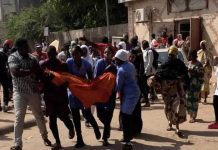By MUHAMMED. S. BAH
The 8th Bilateral meeting between the Gambia Revenue Authority and Senegalese Custom Administration concluded on  Wednesday, 27 July, 2016, at a local hotel in Bijilo.
Wednesday, 27 July, 2016, at a local hotel in Bijilo.
The three day meeting brought together custom experts and other stakeholders from both Senegal and Gambia. Participants came up with a report containing resolutions as well as a Memorandum of Understanding (MoU) with 17 chapters and 41 articles meant to address all the issues of trade and integration between the two countries.
Alieu Ceesay, Commissioner of Customs, who served as the negotiator of the two documents on behalf of the Gambia, gave a summary of the report.
Commissioner Ceesay noted that the document contains all the steps on how the two customs administration can facilitate trade along their borders.
“…but not only to facilitate trade but also, how to share information between the two administrations in order to minimise custom fraud and smuggling of goods across our custom borders. As we know Senegal and Gambia share a lot of trade between us, from cross border, transit and export so all these issues have been addressed,” he said.
Commissioner Ceesay recalled that in the past there used to be problems in terms of delay, transit, among many other problems. “Therefore, this MOU signed between the two has some of the solutions to these problems,” he said.
According to the Custom Commissioner, both parties have come up with recommendations to address all these. He also added that the recommendations and resolutions will ensure that transit and re-export are done according to the international conventions governing transit and re-export.
“Henceforth, we do not foresee any problem, with regards to all these customs issues, transit, re-exports and cross border trade, this will also address the border issue with regards to the free flow of goods,” he noted.
Mr. Ceesay revealed that the MOU is divided into two parts namely Understanding of Administrative Assistance and the Facilitation of Trade. “These are the two concerns that our Governments have,” he added.
Giving a brief summary of the recommendation, Commissioner Ceesay said the first recommendation is on the control system for export and re-export which has been an issue.
In his closing Statement, Yankuba Darboe, Commissioner General GRA, said the discussions during the meeting were highly mutual and beneficial to their work with the hope of improving understanding between the two administrations.
“These gains will greatly improve trade relations between the two nations and even beyond. Decisions reached here will even affect the life of the local trader and consumer in the most remote of our various communities,” he remarked.
He also said “until we keep the agreements reached here and fully implement them such as establishing join customs posts, interfacing of our various automated systems, exchange of information on transit amongst many others, our bilateral would not be seen to be a success”.
For his part, Pape Ousmane Gueye, Director General Senegal Custom Administration, assured them of his administration’s commitment towards achieving the aims of the meeting.
Paul Badji, Executive Director, Senegalo- Gambian Secretariat, while describing the meeting as important, assured them of his secretariat’s commitment towards the recommendations of the meeting.
Professior Saliou Ndiaye, Senegalese Ambassador to the Gambia, highlighted the similarities between the two countries.
Below is the summary of recommendations:
The meeting discussed and agreed on the importance of the procedures and the facilitation of cross border trade. Both administrations agreed that the difficulties encountered in the administration of this important regime are mainly as a result of the unavailability of proper documentation.
Concerns were also raised over vehicles on traffic. Following the detailed discussion on the subject, the meeting agreed on the following recommendations:
- An observatory group to be established.
- Both administration to come up with electronic managers and declaration to capture the export trade data for all border transaction
- Create channel of communication for the exchange of vehicle movement and the establishment of a focal point for the sharing of information on cross border trade in order to reconcile vehicle movement to prevent the smuggling of vehicles. And this format to be adopted for the capturing of information on the re-export trade.
- The stakeholders and other economic actors to be sensitise on the importance of keeping accurate information i.e. their declaration to customs.
- Interconnectivity, the essence of connecting the two systems which is Gaindeh, and Asicuda plus course. In this area both administrations express the importance of the need for the two systems to be interface. It was observed that this initiative was long overdue and could pave the way to harmonise the activities and facilitate the exchange of information.
- The meeting was informed that the Senegal Custom administration is in the process of inter-connecting IT system with Mali, Ivory Cost and Burkina Faso on a project. The Gambia Revenue Authority expresses commitment to inter connect IT system with Senegal and also join the sub-regional inter-connection project. The key issues that were raised by the Gambian delegate
are incompatibility of the two different operating system.
Recommendations on these areas.
- The two administration expressed the need for their systems to be inter-connected
- Form a joint project committee by the end of August 2016, to comprise members from the Customs to study the feasibility of connecting the two systems. The TOR of this project shall be to conduct a feasibility study in order to determine the connectivity of the two systems, determine the accountability of the two systems, come up with a budget for the project and to identify appropriate border stations that should be connected by the two systems.
Both countries agreed that there is need for GRA to join the Project through assistance from the Senegalese Customs.
The project aims to conduct a feasibility study and submit their report before the next bilateral meeting, because all these recommendations have been given a time frame, so that our monitoring community will be able to do their job effectively.
Both administrations have shown the commitment for the construction of a joint custom post at Kerr Ali and Kerr Ayib, Senoba and Misira and the feasibility studies have been conducted on both sites. The meeting was informed that the technical committee had already existed under the Senegalo-Gambian Secretariat. Both administrations should make a regular follow up to ensure the timely implementation of the project.
They have discussed about the ETLS, issues on this including registration and the unavailability of data.
Both administrations recommended the following:
- Both administrations to come up with operational problems affecting the operationalisation of the ETLS.
- Both administrations agreed to maintain a database and regularly update each other on the ETLS operation. Among other issues.
The meeting has recommended the formation of monitoring and evaluation committee comprises of 4 members from each administration that will be responsible for the monitoring of the implementation of the bilateral recommendation.
The Senegalese delegates also shared with their Gambian Counterpart some forms that they can use to exchange information on the movement of vehicles and the movement of goods in and out of Senegal. “We have seen that this is a very important development and it will help us at least control what is coming through our brothers and make cross border trade more easy and transparent for both countries.




















